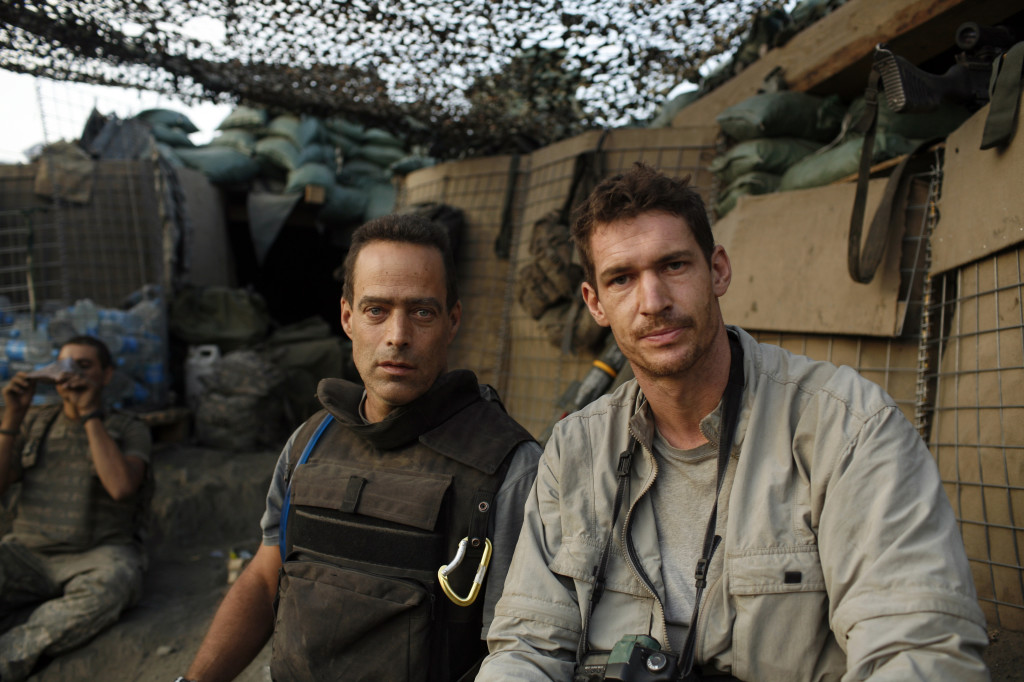Tre anni fa, la morte improvvisa dei fotografi Tim Hetherington e Chris Hondros per le strade di Misurata scosse il mondo del fotogiornalismo.
Il giornalista e documentarista Sebastian Junger ha voluto raccontare la vita e il percorso professionale e personale dell’amico e collega Hetherington nel suo documentario Tim Hetherington: dalla linea del fronte (qui il trailer), in uscita nelle sale il 3 Aprile, distribuito da I Wonder Pictures.
Un pubblico più vasto, rispetto a quello dei reportage, aveva avuto modo di conoscere Hetherington dopo la nomination agli Oscar per Restrepo, il documentario da lui realizzato proprio con Junger registrando per un anno intero la quotidianità di un plotone dell’esercito USA di stanza nella Korengal Valley, in Afghanistan.
Quello che il pubblico non poteva conoscere però, era che tipo di persona fosse, questo ragazzo inglese altissimo che ovunque andava si mescolava alle persone con semplicità e immediatezza. Quello che cerca di fare Junger con questo film è proprio questo: restituire il ritratto di una persona particolare, con un lavoro particolare che svolgeva – ovviamente – in modo tutto suo.
Tim Hetherington non era un fotografo di guerra. O meglio, lo era ma non desiderava esserlo. Quello che più gli interessava era raccontare le storie di quegli esseri umani che si trovano in situazioni estreme come la guerra, che non hanno il pieno controllo delle proprie vite, o che queste vite hanno subìto. Scattava quasi sempre con il medio formato, strumento inadatto alla rapidità della guerra, ma intimo e pregnante, con cui catturava ritratti indimenticabili per la loro profondità.
E poi sempre con la videocamera accesa, contraltare dinamico alle sue Hasselblad e Rolleiflex, era capace di cogliere le storie mentre accadevano, con un punto di vista ancora più simile se possibile a quello delle persone che gli stavano accanto.
Il suo insegnante di fotografia racconta nel documentario come considerasse Tim il suo studente “moderno”, primo tra tutti ad avvicinarsi e a produrre multimediali: rendeva video le sue foto e faceva riprese insieme agli scatti.
Semplice nella forma, compatto nell’uso dei materiali e delle interviste, il ritratto che viene fuori da Tim Hetherington: dalla linea del fronte, è quello di un grande fotografo umanista, una persona semplice e trasparente, fuori dagli schemi del giornalismo di guerra e dalla sua capacità di divorare la storia, morto mentre faceva quello che sapeva fare meglio: raccontare le storie dietro alle persone.
Nella foto: Sebastian Junger (sinistra) e Tim Hetherington (destra) all'avamposto di Restrepo nella Korengal Valley, Afghanistan. © Tim Hetherington
Gabriele Magazzù
ENGLISH VERSION
Three years ago the world of photojournalism was shocked at the sudden death of photographers Tim Hetherington and Chris Hondros on the streets of Misrata.
Journalist and documentarist Sebastian Junger recollects the story of the personal and professional life of his friend and colleague Hetherington in the documentary Which Way Is the Frontline From Here: The Life and Times of Tim Hetherington (here the trailer), out in Italian theaters on April 3rd and distributed by I Wonder Pictures.
A wider audience (not limited to reportages followers) had the chance to discover Hetherington upon his 2011 Academy Award nomination for Best Documentary with Restrepo, a groundbreaking film co-realised with Junger, that follows one year in the daily life of a US army platoon in Korengal Valley, Afghanistan.
However, the public couldn’t know what kind of person Hetherington was - a super tall English lad who would mingle with people wherever he’d go, with simplicity and spontaneity. That’s exactly what Junger tries to deliver with his documentary: the portrait of a particular person working a particular job in his own particular way.
Tim Hetherington wasn’t a war photographer - actually he was, but he wished he weren’t. What interested him the most was to tell the stories of human beings facing such extreme conditions as war - people who don’t have full control over their own lives or have been arbitrarily subjected to them. He would mostly shoot in a medium format (which is an unfitting tool to the rapidity of war, but intimate and emphatic) and capture unforgettable, profound portraits.
As a dynamic counterbalance to his Hasselblad and Rolleiflex, he’d keep his videocamera constantly on, to catch a glimpse of events whilst they were happening - his perspective almost coinciding with that of the people surrounding him.
His Photography teacher remembers Tim as his “modern” student - the very first student who approached and produced multimedia projects. He’d turn his photos into videos, and he’d always videotape while shooting.
Straightforward in the form, compact in the use of materials and interviews, the portrait in Which Way Is the Frontline From Here: The Life and Times of Tim Hetherington is that of a grand humanist photographer, a simple and crystal-clear person who stood out of the war-journalism schemes. He was outstanding in his ability to devour the story-line, and he died doing what he was best at: telling the hidden stories of people.
Pictures: Sebastian Junger (left) and Tim Hetherington (right) at the "Restrepo" Observation Post in Korengal Valley, Afghanistan. © Tim Hetherington
We are a self-funded intiative, and we rely on the expertise each of us has gained in his/her field of specialty. Whilst presenting our interviews and articles, we are looking forward to your feedback to help us improve our English version - anything related to specific words, phrases or idiomatic expression, or any other annotation you might deem useful.
Please email us at info@phom.it.


Leave a Reply